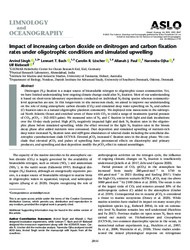Impact of increasing carbon dioxide on dinitrogen and carbon fixation rates under oligotrophic conditions and simulated upwelling
DOI: https://doi.org/10.1002/lno.11795
Persistent URL: http://resolver.sub.uni-goettingen.de/purl?gldocs-11858/9585
Persistent URL: http://resolver.sub.uni-goettingen.de/purl?gldocs-11858/9585
Singh, Arvind; Bach, Lennart T.; Löscher, Carolin R.; Paul, Allanah J.; Ojha, Narendra; Riebesell, Ulf, 2021: Impact of increasing carbon dioxide on dinitrogen and carbon fixation rates under oligotrophic conditions and simulated upwelling. In: Limnology and Oceanography, Band 66, 7: 2855 - 2867, DOI: 10.1002/lno.11795.
 |
Dokument öffnen: |
Dinitrogen (N2) fixation is a major source of bioavailable nitrogen to oligotrophic ocean communities. Yet, we have limited understanding how ongoing climate change could alter N2 fixation. Most of our understanding is based on short‐term laboratory experiments conducted on individual N2‐fixing species whereas community‐level approaches are rare. In this longer‐term in situ mesocosm study, we aimed to improve our understanding on the role of rising atmospheric carbon dioxide (CO2) and simulated deep water upwelling on N2 and carbon (C) fixation rates in a natural oligotrophic plankton community. We deployed nine mesocosms in the subtropical North Atlantic Ocean and enriched seven of these with CO2 to yield a range of treatments (partial pressure of CO2, pCO2 = 352–1025 μatm). We measured rates of N2 and C fixation in both light and dark incubations over the 55‐day study period. High pCO2 negatively impacted light and dark N2 fixation rates in the oligotrophic phase before simulated upwelling, while the effect reversed in the light N2 fixation rates in the bloom decay phase after added nutrients were consumed. Dust deposition and simulated upwelling of nutrient‐rich deep water increased N2 fixation rates and nifH gene abundances of selected clades including the unicellular diazotrophic cyanobacterium clade UCYN‐B. Elevated pCO2 increased C fixation rates in the decay phase. We conclude that elevated pCO2 and pulses of upwelling have pronounced effects on diazotrophy and primary producers, and upwelling and dust deposition modify the pCO2 effect in natural assemblages.
Statistik:
ZugriffsstatistikSammlung:
This is an open access article under the terms of the Creative Commons Attribution License, which permits use, distribution and reproduction in any medium, provided the original work is properly cited.

